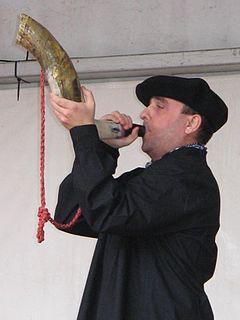 W
WEthnomusicology is the study of music from the cultural and social aspects of the people who make it. It encompasses distinct theoretical and methodical approaches that emphasize cultural, social, material, cognitive, biological, and other dimensions or contexts of musical behavior, in addition to the sound component.
 W
WAfrican Music is an annual peer-revieweded academic journal published by the International Library of African Music. It covers contextualized studies of African music and related arts. Articles are made freely accessible after a two-year embargo period.
 W
WThe Indiana University Archives of Traditional Music holds over 100,000 individual audio and video recordings across over 3500 collections of field, broadcast, and commercial recordings. Its holdings are primarily focused on audiovisual recordings relating to research in the academic disciplines of ethnomusicology, folklore, anthropology, linguistics, and various area studies.
 W
WArja, also known as Balinese opera, is a popular form of Balinese theatre which combines elements of opera, dance, and drama. It was created in 1825 for the funeral of a Balinese prince. In the beginning it had an all-male cast; since the 20th century all performers have been women.
 W
WMantle Hood was an American ethnomusicologist. Among other areas, he specialized in studying gamelan music from Indonesia. Hood pioneered, in the 1950s and 1960s, a new approach to the study of music, and the creation of the first American university program devoted to ethnomusicology, at the University of California, Los Angeles (UCLA). He was known for a suggestion, somewhat novel at the time, that his students learn to play the music they were studying.
 W
WThe blowing horn or winding horn is a sound device that is usually made of or shaped like an animal horn, arranged to blow from a hole in the pointed end of it. This rudimentary device had a variety of functions in many cultures, in most cases reducing its scope to exhibiting, celebratory or group identification purposes. On the other hand, it has kept its function and profile in many cattle raising, agricultural and hunter-gatherer societies.
 W
WCantometrics is a method developed by Alan Lomax and a team of researchers for relating elements of the world's traditional vocal music to features of social organization as defined via George Murdock's Human Relations Area Files, resulting in a taxonomy of expressive human communications style. Lomax defined Cantometrics as the study of singing as normative expressive behavior and maintained that Cantometrics reveals folk performance style to be a "systems-maintaining framework" which models key patterns of co-action in everyday life. His work on Cantometrics gave rise to further comparative studies of aspects of human communication in relation to culture, including: Choreometrics, Parlametrics, Phonotactics, and Minutage.
 W
WThe Country Blues is a seminal book by Samuel Charters, published in 1959 and generally acknowledged as the first scholarly book-length study of country blues music. An album of the same name was issued on Folkways Records as an accompaniment to provide examples of the artists and styles discussed. It was reprinted by Da Capo Press in 1975 with minor edits, and a new introduction by the author.
 W
WEthnochoreology is the study of dance through the application of a number of disciplines such as anthropology, musicology, ethnomusicology, and ethnography. The word itself is relatively recent and etymologically means “the study of ethnic dance”, though this is not exclusive of research on more formalized dance forms, such as classical ballet, for example. Thus, ethnochoreology reflects the relatively recent attempt to apply academic thought to why people dance and what it means.
 W
WThe Federal Music Project (FMP) was a part of the New Deal program Federal Project Number One provided by the U.S. federal government which employed musicians, conductors and composers during the Great Depression. In addition to performing thousands of concerts, offering music classes, organizing the Composers Forum Laboratory, hosting music festivals and creating 34 new orchestras, employees of the FMP researched American traditional music and folk songs, a practice now called ethnomusicology. In the latter domain the Federal Music Project did notable studies on cowboy, Creole, and what was then termed Negro music. During the Great Depression, many people visited these symphonies to forget about the economic hardship of the time. In 1939, the FMP transitioned to the Works Progress Administration's Music Program, which along with many other WPA projects, was phased out in the midst of World War II.
 W
WFree Dirt Records is an American independent record label and label services company founded in 2006 by John Smith and Erica Haskell that releases folk and roots music. The label's releases have received two Grammy nominations.
 W
WGambuh is an ancient form of Balinese dance-drama. It is accompanied by musicians in a gamelan gambuh ensemble.
 W
WGamelan is the traditional ensemble music of the Javanese, Sundanese, and Balinese peoples of Indonesia, made up predominantly of percussive instruments. The most common instruments used are metallophones played by mallets and a set of hand-played drums called kendhang, which register the beat. The kemanak and gangsa are commonly used gamelan instruments in Java. Other instruments include xylophones, bamboo flutes, a bowed instrument called a rebab, siter, and vocalists named sindhen (Female) or gerong (Male).
 W
WShamanic music is music played either by actual shamans as part of their rituals, or by people who, whilst not themselves shamans, wish to evoke the cultural background of shamanism in some way. Therefore, Shamanic music includes both music used as part of shamans' rituals and music that refers to, or draws on, this.
 W
WTanjidor is a traditional Betawi musical ensemble developed in Jakarta, Indonesia. This musical ensamble took form of a modest orchestra, and was developed in the 19th century, pioneered by Augustijn Michiels or better known as Major Jantje in the Citrap or Citeureup area on the outskirt of Batavia.